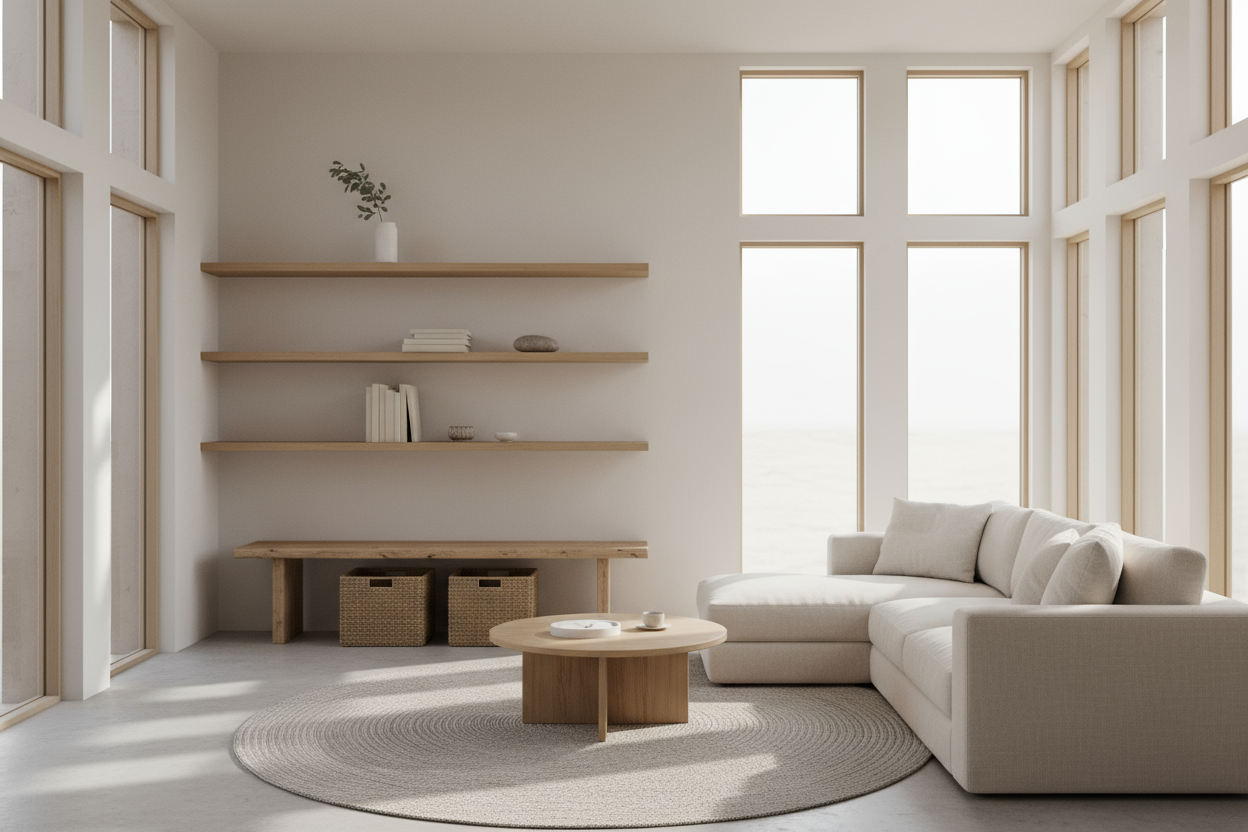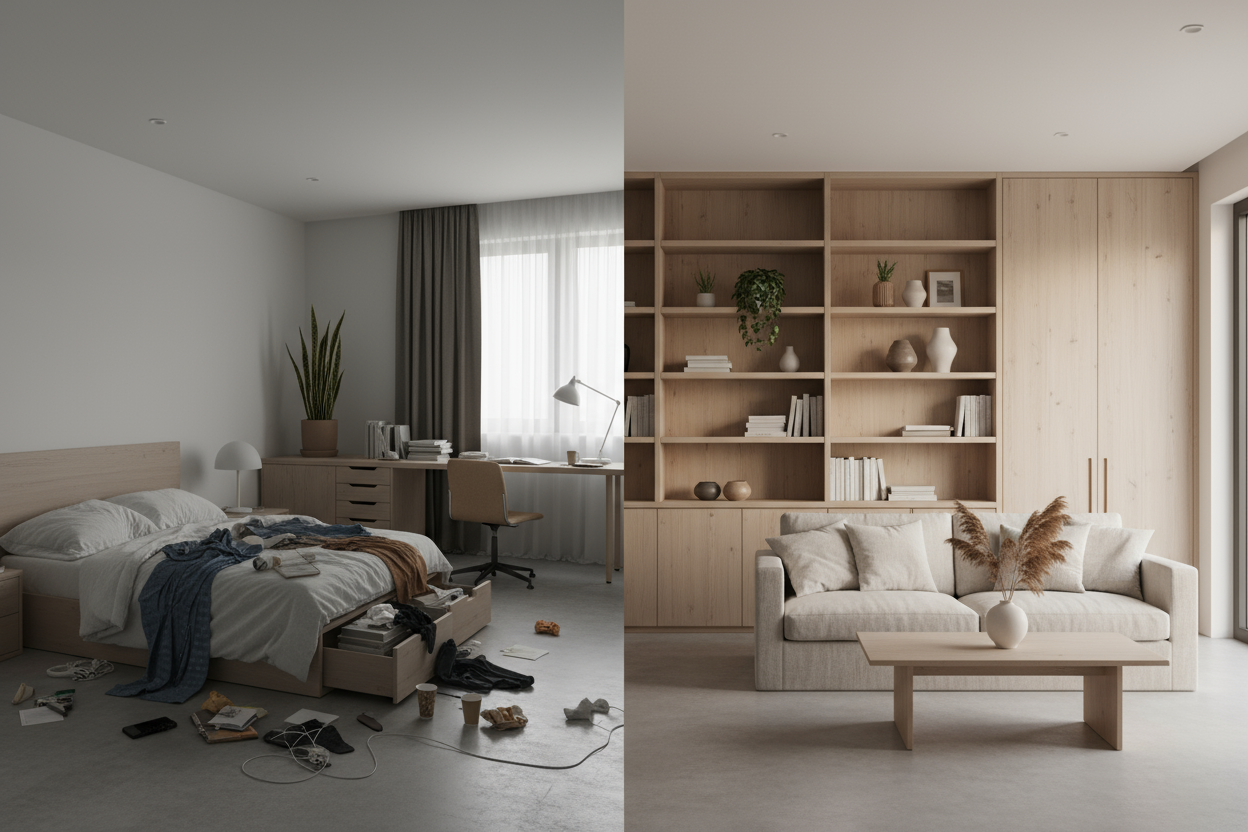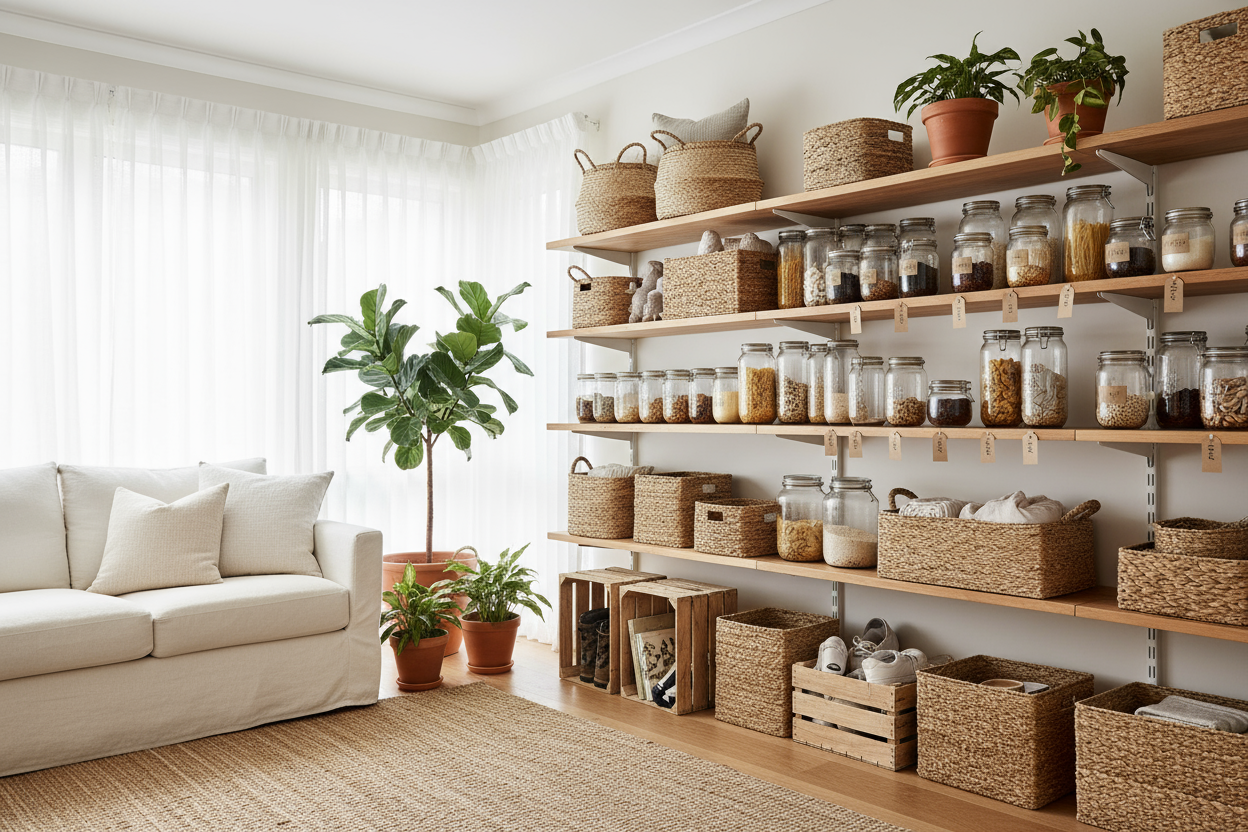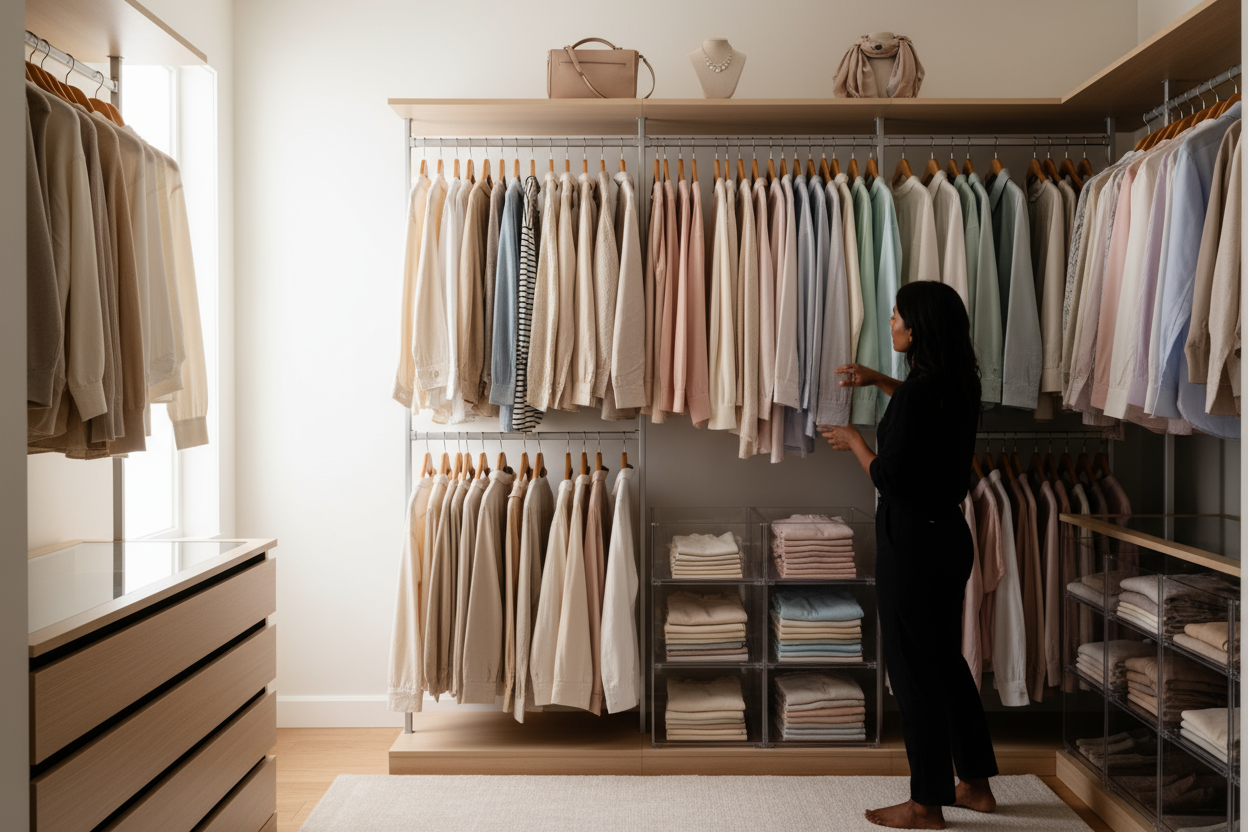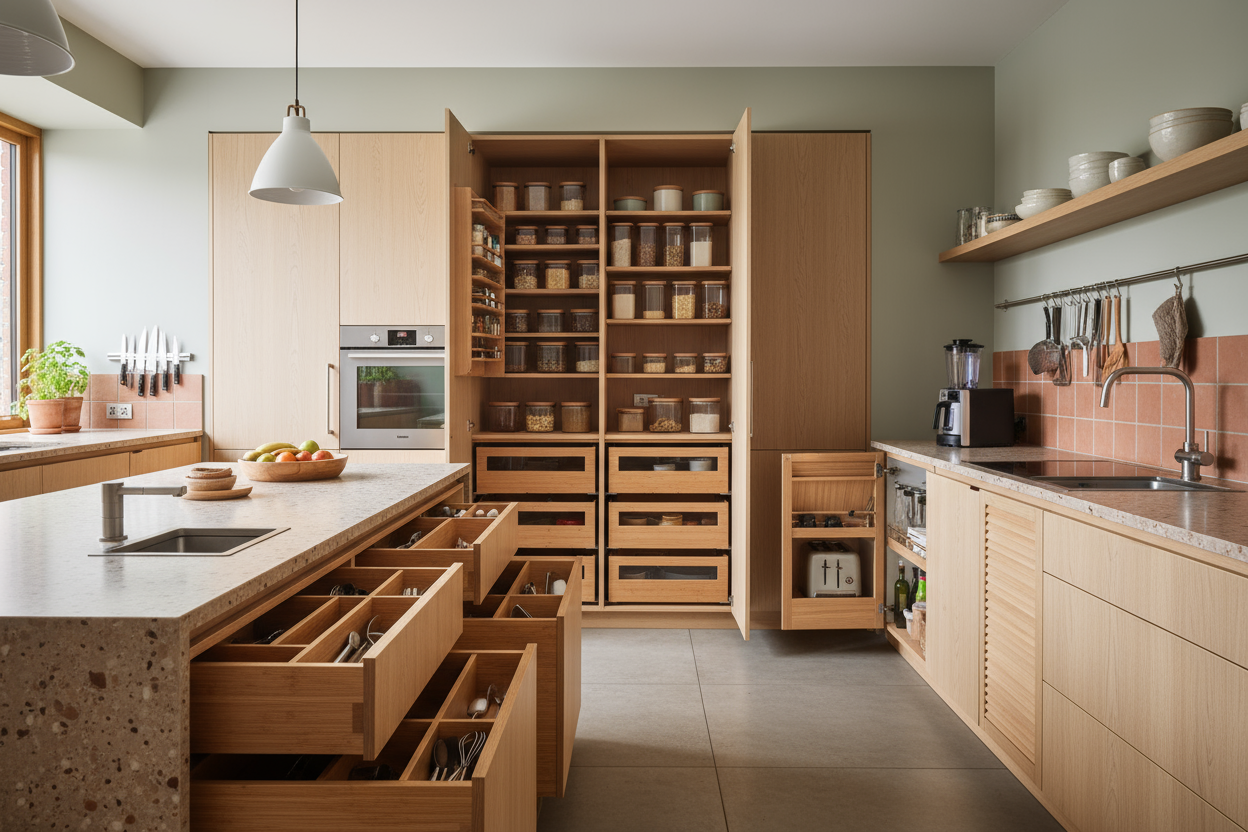Written by a home organisation enthusiast with years of personal experience helping families and individuals simplify their living spaces. This article draws on personal and community learnings from real decluttering journeys.
Living with less clutter doesn't happen overnight, but the journey toward minimalist organisation offers profound rewards. When your home contains only what you truly need and love, daily routines become smoother, cleaning takes less time, and a sense of calm replaces the visual noise of excess possessions. This shift from accumulating to curating transforms not just your physical space but your mental wellbeing too.
The path to minimalist organisation starts with understanding a fundamental principle: you cannot organise your way out of having too much stuff. Real peace comes from thoughtful reduction first, then smart storage solutions for what remains. This approach helps you build spaces that serve your actual lifestyle rather than accommodating items you rarely use.
Why Minimalist Organisation Creates Mental Clarity
When you reduce the volume of possessions competing for your attention, your brain experiences genuine relief. Community observations consistently show that people who eliminate excess kitchenware report feeling lighter both physically and mentally (insert peer-reviewed citation). The simple act of reducing 50 mugs down to just two or three creates immediate benefits during daily routines and makes relocating much easier when life circumstances change.
This mental clarity extends beyond physical objects. Many people discover that releasing items tied to family expectations or inherited guilt produces emotional freedom. Letting go of unused china sets or silverware that served someone else's lifestyle allows you to prioritise your current needs over inherited obligations. The emotional weight of maintaining items out of duty rather than love can be surprisingly heavy.
Digital minimalism plays an equally important role in creating mental space. Eliminating social media accounts that serve no meaningful purpose reduces comparison traps, advertising overload, and attention fragmentation. A quieter digital environment supports better focus and genuine peace, though this remains a personal choice based on individual circumstances and professional requirements.
Example storage options here: drawer dividers, modular pantries, or over-door organizers can keep essentials tidy without visual clutter.
Starting Your Decluttering Journey
The Foundation: Declutter Before You Organise
The most effective minimalist strategy challenges conventional organisation advice. Rather than purchasing storage solutions for everything you own, focus entirely on eliminating items that don't serve your current life. This approach prevents the common trap of simply hiding clutter in prettier containers.
Begin with high-impact areas where excess creates daily friction. Kitchens typically offer the most dramatic results because redundant gadgets, mismatched containers, and duplicate items accumulate quickly. Community experience suggests that clearing these functional spaces first provides motivation to tackle more sentimental areas later.
Room-by-Room Approach
Tackle one space completely before moving to the next. This prevents the overwhelming feeling of having disrupted your entire home simultaneously. Create an "outbox" for items you're unsure about, then revisit these pieces after completing the immediate room. Often, the clarity gained from decluttering surrounding areas makes decisions about borderline items much easier.
Document your progress with photographs. Visual evidence of transformation provides powerful motivation during challenging moments and helps you recognise patterns in what you're choosing to keep or release. This technique proves particularly valuable when working through sentimental items that carry emotional weight.
Tackling Common Clutter Categories
Kitchen Essentials
Start with obvious duplicates and gadgets you haven't used in the past year. Many people discover they can prepare all their favourite meals with surprisingly few tools. Focus on versatile pieces that serve multiple functions rather than single-purpose gadgets that consume valuable storage space.
Practical kitchen storage solutions for your remaining essentials can transform daily cooking routines. Organised spice storage, streamlined pantry containers, and efficient dish drying systems support the minimalist kitchen without adding visual clutter.
Example storage options here: drawer dividers, modular pantries, or over-door organizers can keep essentials tidy without visual clutter.
Wardrobe Simplification
Community wisdom consistently points to wardrobe reduction as a source of significant daily relief (insert observational study or survey citation). Simplifying clothing choices to versatile staples minimises decision fatigue each morning while reducing the temptation for wasteful purchases. A smaller, consistent wardrobe typically matches real lifestyle needs better than collections of trendy or aspirational pieces.
Consider attempting a capsule wardrobe challenge, keeping only items that mix and match easily. Many people find that 30 thoughtfully chosen pieces create more outfit possibilities than overstuffed wardrobes filled with items they rarely wear. Smart wardrobe storage helps maintain this simplified system long-term.
Example storage options here: drawer dividers, modular pantries, or over-door organizers can keep essentials tidy without visual clutter.
Books and Sentimental Items
Letting go of books often represents a significant psychological shift toward functional ownership. Even beloved volumes can be released when you acknowledge that their content remains accessible through libraries or digital formats. Community experience suggests that donating books creates space for current interests while helping others discover great reads.
For truly sentimental documents and photographs, digitising offers an excellent compromise. Scanning important papers and favourite images preserves memories while dramatically reducing physical storage requirements. Limit physical mementos to one or two boxes of items that genuinely bring joy when rediscovered.
Building Sustainable Organisation Systems
Assign Everything a Home
Once you've reduced possessions to what you actually use and love, create designated spots for everything that remains. This principle prevents the gradual accumulation of homeless items that create visual clutter over time. Every object should have a logical, accessible location that supports how you actually use it.
Establish an entryway drop zone for items that typically get scattered throughout the house: keys, mail, bags, and seasonal accessories. This single organised space prevents these necessities from migrating to kitchen counters, dining tables, or bedroom furniture.
Bathroom and Laundry Organisation
Bathrooms benefit enormously from minimalist principles because the space constraints make clutter particularly noticeable. Focus on keeping only products you use regularly, and find efficient storage for backup supplies without creating visual chaos.
Laundry routines become much more pleasant with thoughtful storage solutions that support your actual washing, drying, and folding habits. Systems that make these necessary tasks easier encourage consistency, preventing the buildup of clothing-related clutter.
Example storage options here: drawer dividers, modular pantries, or over-door organizers can keep essentials tidy without visual clutter.
Example storage options here: drawer dividers, modular pantries, or over-door organizers can keep essentials tidy without visual clutter.
Maintaining Your Minimalist Space
Daily Habits for Long-term Success
Sustainable organisation depends more on consistent small actions than periodic major overhauls. Develop routines that prevent clutter accumulation: process mail immediately, return items to their designated homes after use, and regularly evaluate whether new purchases align with your minimalist goals.
The "one in, one out" rule helps maintain equilibrium once you've achieved your desired level of simplicity. When you bring something new into your home, consciously choose something else to donate or discard. This practice prevents the gradual creep back toward cluttered spaces.
Seasonal Reviews
Schedule quarterly reviews of your main living spaces to identify items that are no longer serving your current lifestyle. Needs change, and minimalist organisation should evolve accordingly. These regular check-ins help you catch accumulation early and make adjustments before clutter becomes overwhelming again.
Pay special attention to areas where items tend to collect: entryways, kitchen counters, bedroom surfaces, and bathroom edges. These zones often signal broader organisational challenges and provide early warning when systems need adjustment.
When Minimalism Feels Challenging
Some decluttering decisions require careful consideration of your specific circumstances. For items with genuine financial value, research donation options that provide tax benefits or consider selling through appropriate channels. This approach honours the resources you invested while still achieving your minimalist goals.
Family members may initially resist household minimalism, especially children who form attachments to toys and possessions. Involve them in age-appropriate ways, focusing on donating items to help other families rather than simply discarding things. This teaching opportunity can build lifelong skills around conscious consumption.
Remember that minimalist organisation is deeply personal. What feels peaceful and functional in your home may differ significantly from others' interpretations. Trust your instincts about what level of simplicity supports your wellbeing rather than pursuing someone else's aesthetic ideal.
Moving Forward with Confidence
Minimalist home organisation offers a pathway to greater daily peace, but the journey requires patience with yourself and realistic expectations. Focus on progress rather than perfection, celebrating the mental clarity and practical benefits that emerge as you reduce excess and organise what remains.
The goal isn't to live in a stark, uncomfortable space but to curate an environment that genuinely supports your best life. When your home contains only items you use and appreciate, maintaining organisation becomes natural rather than burdensome. This shift from managing clutter to enjoying simplicity creates lasting satisfaction that extends well beyond your physical spaces.
Start small, stay consistent, and trust that each conscious choice to prioritise function over accumulation moves you closer to the peaceful, organised home you deserve.


